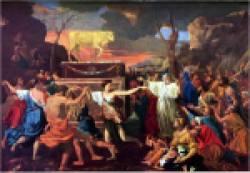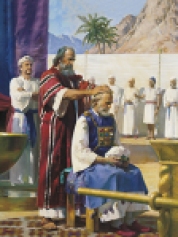Does Jehovah choose only the direct descendants of Aaron as priests OR all of the tribe of Levi? (Exodus 28:1, 28:41, 29:1-9, 40:12-16; Leviticus 1-8; Numbers 3:1-9, 25:10-12 versus Exodus 32 and Deuteronomy 18:1-8)
“Bring Aaron, your brother, forward to you, and his sons with him, from among the children of Israel for him to function as a priest for me.” (Exodus 28:1)
The edited text of the Pentateuch as we now have it bears witness to the rivalry that existed within the tribe of Levi over who was in control of the priesthood. Both the sons of Aaron and the tribe of Levi wanted to legitimize their rightful claim as heirs of the priesthood of God. Sometimes Latter-day Saints may think of the sons of Aaron and the Levites as the same thing – they weren’t. From Encyclopedia of Mormonism we read,
Moses and his brother Aaron belonged to the tribe of Levi. Latter-day revelation indicates that before Moses died, the Melchizedek Priesthood and the higher law of the gospel were withdrawn from the Israelites because of their disobedience. Aaron and his sons were then given a lesser priesthood to administer the lesser Law of Moses as priests in Israel (D&C 84:18-28; Exodus 28:1). To assist Aaron and his sons, other worthy male members of the tribe of Levi were also given authority in the lesser priesthood, although they could not be priests. The keys of that priesthood remained with Aaron and his direct posterity (MD, pp. 9-10; Widtsoe, pp. 12-17). Hence, the lesser priesthood was called the Aaronic Priesthood, after Aaron, but is sometimes referred to as the Levitical Priesthood because all those who possessed it in ancient times belonged to the tribe of Levi (Numbers 3:12-13). 1
Scholars refer to the divergent viewpoints in the Bible as arriving from “schools” or scribal traditions whereby each scribal school emphasized different stories, aspects of diety, and treated the themes in their stories with a view in mind to put forth their claims. 2 The “priestly school” had, in the mind of many biblical scholars, a division. One school was in favor of the Levites holding the priesthood, the other was against the Levites holding this priesthood, the descendants of Aaron (or as I refer to them, the House of Aaron), sometimes called the Aaronids. These two priestly schools—the Aaronids and the Levites—had vastly different and competing views on religion, the role of the cult and its priesthood, Jehovah, ethics, how sin was to be atoned, and Jehovah’s covenants. 3
 Our first indication of this internal priestly rivalry and how priestly scribes composed ancient literary works to validate their supremacy comes in story of Aaron and the Golden Calf (Exodus 32). Here we see how Aaron, the head and father figure of the House of Aaron, or the Aaronid priests, is negatively represented as the founder of Israel’s “great shame.” (Exodus 32:25) The text goes to great lengths to present Aaron as Israel’s first apostate while demonstrating that the Levites were the obedient followers of Jehovah (see Exodus 32:28).
Our first indication of this internal priestly rivalry and how priestly scribes composed ancient literary works to validate their supremacy comes in story of Aaron and the Golden Calf (Exodus 32). Here we see how Aaron, the head and father figure of the House of Aaron, or the Aaronid priests, is negatively represented as the founder of Israel’s “great shame.” (Exodus 32:25) The text goes to great lengths to present Aaron as Israel’s first apostate while demonstrating that the Levites were the obedient followers of Jehovah (see Exodus 32:28).
Exodus 32 shows us that Moses and the Levites are the true agents of God who expiate, atone, or pay for Aaron’s sin, and its sinners from Israel (Exodus 32:28-29). This chapter in Exodus portrays the Levites in a favorable light while showing that Aaron “plagued the people” (Exodus 32:35). Deuteronomy 18:1-8 also emphasizes that the Levites are the priests, “The priests the Levites, and all the tribe of Levi… shall have no inheritance among their brethren: the LORD is their inheritance” (Deuteronomy 18:1-2).
 Yet other texts in the Pentateuch contradict these claims, and have Jehovah stating just the opposite: only the Aaronids are priests (Exodus 28:1, 28:41, 29:1-9, 40:12-16; Leviticus 1-8; Numbers 3:1-9, 25:10-12). Not only do the Levites not hold priesthood in these texts, they are demoted to the role of mere ministers to the House of Aaron (Numbers 3:5-10, 16:8-11, 16:17, 18:1-7). Notice in Numbers 18, the Levites cannot even come close to the vessels of the sanctuary, and if they do, they will die! (Numbers 18:3)
Yet other texts in the Pentateuch contradict these claims, and have Jehovah stating just the opposite: only the Aaronids are priests (Exodus 28:1, 28:41, 29:1-9, 40:12-16; Leviticus 1-8; Numbers 3:1-9, 25:10-12). Not only do the Levites not hold priesthood in these texts, they are demoted to the role of mere ministers to the House of Aaron (Numbers 3:5-10, 16:8-11, 16:17, 18:1-7). Notice in Numbers 18, the Levites cannot even come close to the vessels of the sanctuary, and if they do, they will die! (Numbers 18:3)
Why do these conflicts exist in the text? What is happening here? Why are these conflicts not addressed in the Joseph Smith Translation? How are we to interpret this information? How can I apply this information about the Bible in my personal life? What message does God have for us in this information? What does this say about the Bible? Why all of this messiness? These are some of the questions I will try to work through in upcoming posts.
Notes
- Encyclopedia of Mormonism, Levitical Priesthood.
- Karel Van Der Toorn, Scribal Cultural and the making of the Hebrew Bible, Harvard University Press, 2007. Chapter 2: Authorship in Antiquity, 27-49. Van Der Toorn states, “Authors, in antiquity, were scribes… It captures the professional affiliation of those to whom we owe both the books of the Bible and the literary classics of Mesopotamia. Authors belonged to a certain social category or class. Any attempt to enter into the minds of those authors has to be based on knowledge of the class to which they belonged… The evidence shows that we will truly understand the authors of antiquity only by studying the scribal milieu. (p. 48-49)
- Mark Smith, God in Translation: Deities in Cross-Cultural Discourse in the Biblical World, p. 226-228. He states that, “The Levites seem to be have been regarded as second-class personnel, no longer sacrificial priests as such” p. 227.

No Comments
Comments are closed.